Effectiveness of the Overtaking Ban for Heavy Vehicles on the Four-Lane Divided Highway in Different Weather Conditions
Abstract
1. Introduction and Background
- Prohibit the driving of slow vehicles (usually heavy trucks and buses) in the overtaking lane, introduce a combination of “minimum speed” traffic signs in individual lanes (e.g., 110 km/h in the left lane—lane 2 and 80 km/h in the right lane—lane 1), or install “no overtaking by HGVs” traffic signalisation [37];
- Additionally, display the limit of the generally permitted speed as a preventive measure or limit the speed on the carriageway by one level;
- Advise drivers to adjust their speed to the traffic flow; the AHTMS uses arrow signals on VMSs to encourage the same direction of travel without changing lanes and, if necessary, set a minimum speed limit for each lane;
- Advise drivers to drive according to the driving rules, first in the right lane and then in the overtaking lane, when such a manoeuvre is required (e.g., message “left lane: overtaking only” for the case of the right-hand traffic rules).
2. Traffic Characteristics and Weather in Slovenia
Traffic Flow Speed Analysis
- Z1: exclusion for camper vans, refrigerator vehicles, and sheeted vehicles with the MAM of 8 t (wind from 80 km/h to 99 km/h);
- Z2: exclusion for camper vans, all sheeted vehicles, and refrigerator vehicles (wind from 100 km/h to 129 km/h);
- Z3: exclusion for camper vans, all Z2 level vehicles, and buses (wind from 130 km/h to 149 km/h);
- Z4: ban for all vehicles—road closure (wind over 150 km/h).
3. Modelling the Efficiency of Traffic Lane Control and Weather Conditions
- Without traffic control restrictions and without separate consideration of weather conditions c; “ALL” weather conditions are considered—NB_ALL simulations (Figure 6a);
- Without traffic control restrictions, but with weather conditions c considered—NB_c simulations (Figure 6a):
- NB_d simulation taking into account the empirical speed distribution functions of light (F-0178,Vpc,i,d) and heavy vehicles (F-0178,Vhv,i,d), in traffic lanes i = {1, 2}, in “dry” and fair weather (Figure 3);
- NB_w1-, NB_w2-, NB_w3 simulation by taking into account the empirical speed distribution functions of light (F-0178,Vpc,i,wi) and heavy vehicles (F-0178,Vhv,i,wi), in traffic lanes with different precipitation intensities and wetness of road surface (Figure 3);
- NB_lv simulation by taking into account the empirical speed distribution function of light (F-0178,Vpc,i,lv) and heavy vehicles (F-0178,Vhv,i,lv) in traffic lanes with “poor visibility” (Figure 3);
- NB_s simulation by taking into account the empirical speed distribution function of light (F-0178,Vpc,i,s) and heavy vehicles (F-0178,Vhv,i,s) in traffic lanes under “winter conditions” (Figure 3);
- With the traffic control of “overtaking ban for HGVs”, but with consideration of road-weather conditions c—WB_c simulations (Figure 6b): {WB_d, WB_w1, WB_w2, WB_w3, WB_lv, WB_s}. The road-weather conditions were determined parametrically using the corresponding empirical speed distribution functions of light and heavy vehicles as presented in the previous section.
4. Results and Discussion
5. Conclusions
Author Contributions
Funding
Institutional Review Board Statement
Informed Consent Statement
Data Availability Statement
Acknowledgments
Conflicts of Interest
References
- Barcelo, J. Models, Traffic Models, Simulation, and Traffic Simulation. In Fundamentals of Traffic Simulation; International Series in Operations Research & Management Science; Springer: Berlin/Heidelberg, Germany, 2010; Volume 145, pp. 1–62. [Google Scholar]
- De Oliveira, L.B.; Camponogara, E. Multi-Agent Model Predictive Control of Signaling Split in Urban Traffic Networks. Transp. Res. Part C Emerg. Technol. 2010, 18, 120–139. Available online: https://www.sciencedirect.com/science/article/pii/S0968090X09000540 (accessed on 2 September 2022). [CrossRef]
- Steinhoff, C.; Keller, H.; Kates, R.; Farber, B. Driver Perceptions of the Effectiveness of VMS. In Proceedings of the 7th World Congress on Intelligent Transport Systems, Turin, Italy, 6–9 November 2000. [Google Scholar]
- Sándor, Z. Effects of Weather Related Safety Messages on the Motorway Traffic Parameters. Period. Polytech. Transp. Eng. 2017, 45, 58–66. Available online: https://pp.bme.hu/tr/article/view/9117 (accessed on 2 September 2022). [CrossRef]
- van Nes, N.; Brandenburg, S.; Twisk, D. Improving Homogeneity by Dynamic Speed Limit Systems. Accid. Anal. Prev. 2010, 42, 944–952. Available online: https://www.sciencedirect.com/science/article/pii/S0001457509000992 (accessed on 2 September 2022). [CrossRef]
- Hidas, P. Modelling Lane Changing and Merging in Microscopic Traffic Simulation. Transp. Res. Part C Emerg. Technol. 2002, 10, 351–371. Available online: https://www.sciencedirect.com/science/article/pii/S0968090X02000268 (accessed on 2 September 2022). [CrossRef]
- Sun, K.; Zhao, X.; Wu, X. A Cooperative Lane Change Model for Connected and Autonomous Vehicles on Two Lanes Highway by Considering the Traffic Efficiency on Both Lanes. Transp. Res. Interdiscip. Perspect. 2021, 9, 100310. Available online: https://www.sciencedirect.com/science/article/pii/S2590198221000178 (accessed on 2 September 2022). [CrossRef]
- Hoseini, S.M.S. Comparison of Microscopic Drivers’ Probabilistic Lane-Changing Models with Real Traffic Microscopic Data. Promet. Traffic Transp. 2011, 23, 241–251. [Google Scholar] [CrossRef]
- Wall, G.; Hounsell, N. Microscopic Modeling of Motorway Diverges. Eur. J. Transp. Infrastruct. Res. 2005, 5, 139–158. [Google Scholar]
- Heidemann, D. Distribution of Traffic to the Individual Lanes on Multilane Unidirectional Roadways. In Proceedings of the Second International Symposium on Highway Capacity, Sydney, Australia, August 1994; Australian Road Research Board: Vermont South, Australia; Transportation Research Board: Washington, DC, USA, 1994; Volume 1, pp. 265–276. [Google Scholar]
- Li, L.; Wang, F.-Y. The Automated Lane-Changing Model of Intelligent Vehicle Highway Systems. In Proceedings of the IEEE 5th International Conference on Intelligent Transportation Systems, IEEE, Singapore, 6 September 2002; pp. 216–218. [Google Scholar]
- Wu, N. Equilibrium of Lane Flow Distribution on Motorways. Transp. Res. Rec. 2006, 1965, 48–59. Available online: https://journals.sagepub.com/doi/pdf/10.1177/0361198106196500106 (accessed on 2 September 2022). [CrossRef]
- Daganzo, C.F. A Behavioral Theory of Multi-Lane Traffic Flow. Part I: Long Homogeneous Freeway Sections. Transp. Res. Part B Methodol. 2002, 36, 131–158. [Google Scholar] [CrossRef]
- Pompigna, A.; Rupi, F. Lane-Distribution Models and Related Effects on the Capacity for a Three-Lane Freeway Section: Case Study in Italy. J. Transp. Eng. Part A Syst. 2017, 143, 05017010. Available online: https://ascelibrary.org/doi/10.1061/JTEPBS.0000080 (accessed on 2 September 2022). [CrossRef]
- Farooq, D.; Juhasz, J. Simulation-Based Analysis of the Effect of Significant Traffic Parameters on Lane Changing for Driving Logic “Cautious” on a Freeway. Sustainability 2019, 11, 5976. [Google Scholar] [CrossRef]
- Grabec, I.; Kalcher, K.; Švegl, F. Modeling and Forecasting of Traffic Flow. Nonlinear Phenom. Complex Syst. 2010, 13, 53–63. [Google Scholar]
- Transportation Research Board. Highway Capacity Manual 6th Edition: A Guide for Multimodal Mobility Analysis; The National Academies Press: Washington, DC, USA, 2016. [Google Scholar]
- Xiao, C.; Shao, C.; Meng, M.; Wang, P.; Wang, B. Lane Flow Distribution of a Long Continuous Highway. Int. J. Transp. Econ. Eng. Law 2014, 56, 1–16. [Google Scholar]
- Rijavec, R.; Šemrov, D. Effects of Weather Conditions on Motorway Lane Flow Distributions. Promet. Traffic. Traffico 2017, 30, 83–92. Available online: https://traffic.fpz.hr/index.php/PROMTT/article/view/2521 (accessed on 2 September 2022). [CrossRef]
- Haug, A.; Grosanic, S. Usage of Road Weather Sensors for Automatic Traffic Control on Motorways. Transp. Res. Procedia 2016, 15, 537–547. Available online: https://www.sciencedirect.com/science/article/pii/S2352146516305774 (accessed on 2 September 2022). [CrossRef]
- Calvert, S.; Snelder, M. Influence of Weather on Traffic Flow: An Extensive Stochastic Multi-Effect Capacity and Demand Analysis. In European Transport/Trasporti Europei; Institute for Transport Studies in the European Economic Integration: Trieste, Italy, 2016; Volume 60, pp. 1–24. [Google Scholar]
- Weng, J.; Liu, L.; Rong, J. Impacts of Snowy Weather Conditions on Expressway Traffic Flow Characteristics. Discrete Dyn. Nat. Soc. 2013, 2013, 791743. Available online: https://downloads.hindawi.com/journals/ddns/2013/791743.pdf (accessed on 2 September 2022). [CrossRef]
- Aaheim, H.A.; Hauge, K.E. Impacts of Climate Change on Travel Habits—A National Assessment Based on Individual Choices; CICERO Center for International Climate and Environmental Research: Oslo, Norway, 2005. [Google Scholar]
- Skvarča, S. Impact of Weather on Traffic Flow Characteristics. Bachelor’s Thesis, University of Ljubljana, Ljubljana, Slovenia, 2013. (In Slovenian). [Google Scholar]
- Kršmanc, R. Road Surface Condition Forecasting from Historical Data and Weather Forecast. Ph.D. Thesis, University of Ljubljana, Ljubljana, Slovenia, 2013. Available online: http://eprints.fri.uni-lj.si/2109/1/Krsmanc1.pdf (accessed on 2 September 2022). (In Slovenian).
- Rudloff, C.; Leodolter, M.; Bauer, D.; Auer, R.; Brög, W.; Knud, K. Influence of Weather on Transport Demand: A Case Study from the Vienna Region. In Proceedings of the Transportation Research Board (TRB) 94th Annual Meeting, Washington, DC, USA, 11–15 January 2015. [Google Scholar]
- Billot, R.; El Faouzi, N.-E.; De Vuyst, F. Multilevel Assessment of the Impact of Rain on Drivers’ Behavior. Transp. Res. Rec. J. Transp. Res. Board 2009, 2107, 134–142. Available online: https://journals.sagepub.com/doi/10.3141/2107-14 (accessed on 2 September 2022). [CrossRef]
- Hablas, H.E. A Study of Inclement Weather Impacts on Freeway Free-Flow Speed by a Study of Inclement Weather Impacts on Freeway Free-Flow Speed. Master’s Thesis, Virginia Polytechnic Institute and State University, Blacksburg, VA, USA, 2007; p. 112. [Google Scholar]
- Ibrahim, A.T.; Hall, F.L. Effect of Adverse Weather Conditions on Speed–Flow Occupancy Relationships. Transp. Res. Rec. 1994, 1457, 184–191. [Google Scholar]
- Huzjan, B.; Mandžuka, S.; Kos, G. Real-Time Traffic Safety Management Model on Motorways. Teh. Vjesn. Tech. Gaz. 2017, 24, 1457–1469. Available online: https://hrcak.srce.hr/188243 (accessed on 2 September 2022).
- Duret, A.; Ahn, S.; Buisson, C. Lane Flow Distribution on a Three-Lane Freeway: General Features and the Effects of Traffic Controls. Transp. Res. Part C Emerg. Technol. 2012, 24, 157–167. Available online: https://www.sciencedirect.com/science/article/pii/S0968090X12000307 (accessed on 2 September 2022). [CrossRef]
- Lee, J.; Park, B.B. Lane Flow Distributions on Basic Segments of Freeways Under Different Traffic Conditions. In Proceedings of the Transportation Research Board 89th Annual Meeting, Washington, DC, USA, 10–14 January 2010; Transportation Research Board: Washington, DC, USA, 2010. [Google Scholar]
- Sabir, M. Weather and Travel Behaviour. Ph.D. Thesis, VU University, Amsterdam, The Netherlands, 2011. [Google Scholar]
- BASt. Technische Lieferbedingungen Für Streckenstationen; TLS 2012; Bundesanstalt für Straßenwesen (BASt): Bergisch Gladbach, Germany, 2012; Available online: https://www.bast.de/DE/Publikationen/Regelwerke/Verkehrstechnik/Unterseiten/V5-tls.html (accessed on 2 September 2022).
- Nagy, E.; Sándor, Z. Overtaking Ban for Heavy Goods Vehicle in Hungary on the National Motorway Network. Pollack Period. 2012, 7, 83–95. [Google Scholar] [CrossRef]
- DARS. Guidelines for the Traffic Control System on Highways in the Republic of Slovenia; DARS: Celje, Slovenia, 2004. [Google Scholar]
- European Commision. EasyWay Harmonising European ITS Services and Actions, Traffic Management Services, HGV OVERTAKING BAN, Deployment Guideline (TMS-DG06) v 2.0; Alain, R., Ed.; European Commision (DG MOVE): Brussels, Belgium, 2012. [Google Scholar]
- Hardman, E.; Morris, B.; Owlett, P.; Rees, T. Directorate General for Internal Policies, Policy Department B Structural and Cohesion Policies, Transport and Tourism: The Impact of Overtaking Bans for HGVs on Two-Lane Highways, on Traffic Flow and Routes of Transport; TRL Limited: Brussels, Belgium, 2010; Available online: https://www.europarl.europa.eu/thinktank/en/document/IPOL-TRAN_NT(2010)431607 (accessed on 2 September 2022).
- Schengen: A Guide to the European Border-Free Zone. Available online: https://www.europarl.europa.eu/news/en/headlines/security/20190612STO54307/schengen-a-guide-to-the-european-border-free-zone (accessed on 6 September 2022).
- Neuburger, L.; Egger, R. Travel Risk Perception and Travel Behaviour during the COVID-19 Pandemic 2020: A Case Study of the DACH Region. Curr. Issues Tour. 2021, 24, 1003–1016. [Google Scholar] [CrossRef]
- DRSI Slovenian Infrastructure Agency. Road Traffic Loads Since 1997. In Open Data of Slovenia 2020. Available online: https://podatki.gov.si/dataset/pldp-karte-prometnih-obremenitev (accessed on 2 September 2022).
- Kyte, M.; Khatib, Z.; Shannon, P.; Kitchener, F. Effect of Environmental Factors on Free-Flow Speed. In Proceedings of the 4th International Symposium on Highway Capacity, Maui, HI, USA, 27 June–1 July 2000; pp. 108–119. [Google Scholar]
- Chen, C.; Zhao, X.; Liu, H.; Ren, G.; Zhang, Y.; Liu, X. Assessing the Influence of Adverse Weather on Traffic Flow Characteristics Using a Driving Simulator and VISSIM. Sustainability 2019, 11, 830. [Google Scholar] [CrossRef]
- Traffic Information Centre for Public Roads Wind Measuring System Burja (Vipava Valley). Available online: https://www.promet.si/en/burja-wind (accessed on 6 September 2022).
- PTV Group. PTV Vissim 2022 User Manual; PTV Group: Karlsruhe, Germany, 2022; p. 1378. [Google Scholar]
- Grumert, E.F.; Tapani, A.; Ma, X. Characteristics of Variable Speed Limit Systems. Eur. Transp. Res. Rev. 2018, 10, 21. [Google Scholar] [CrossRef]
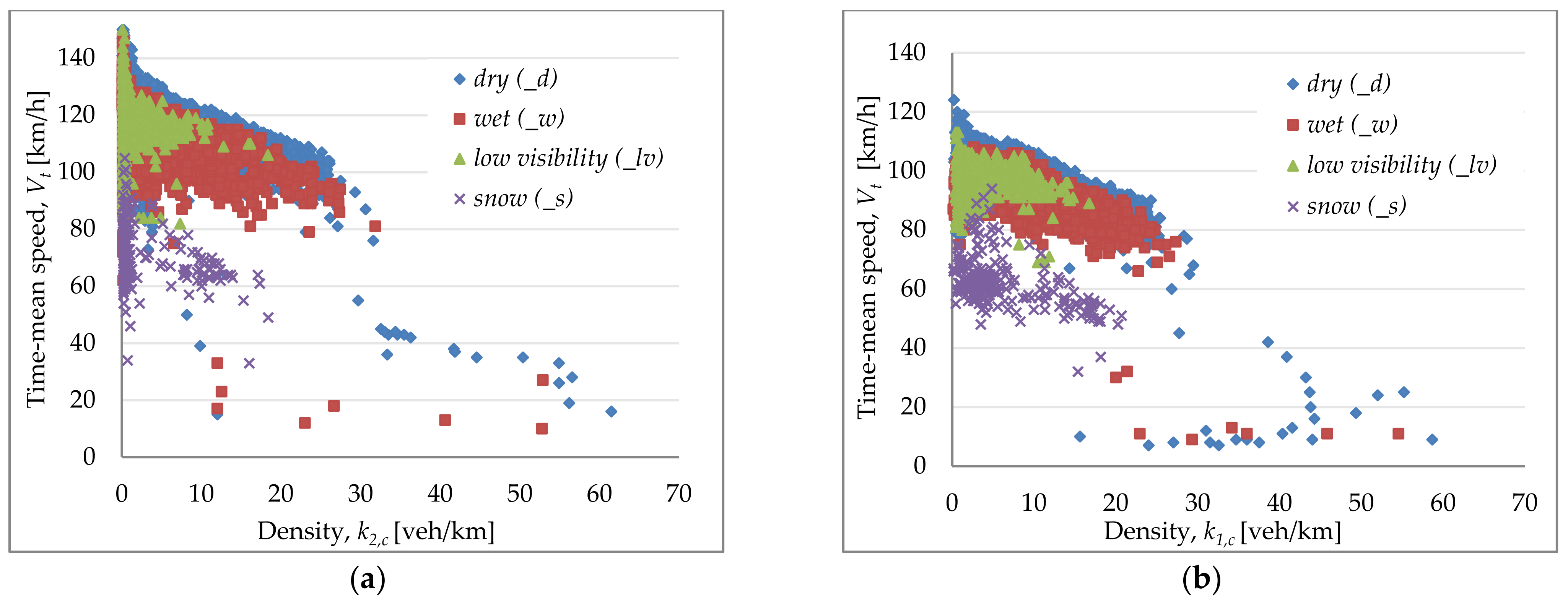

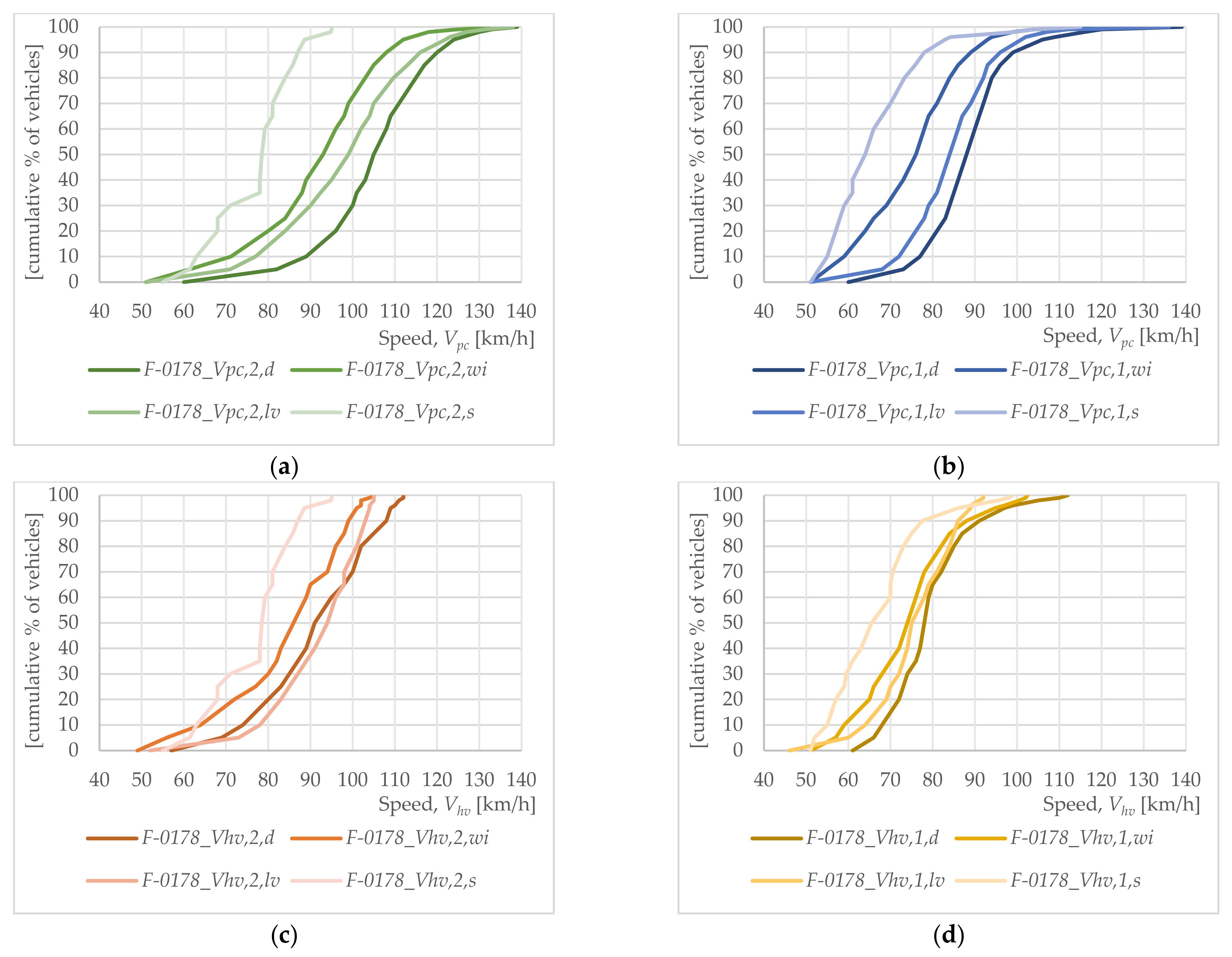

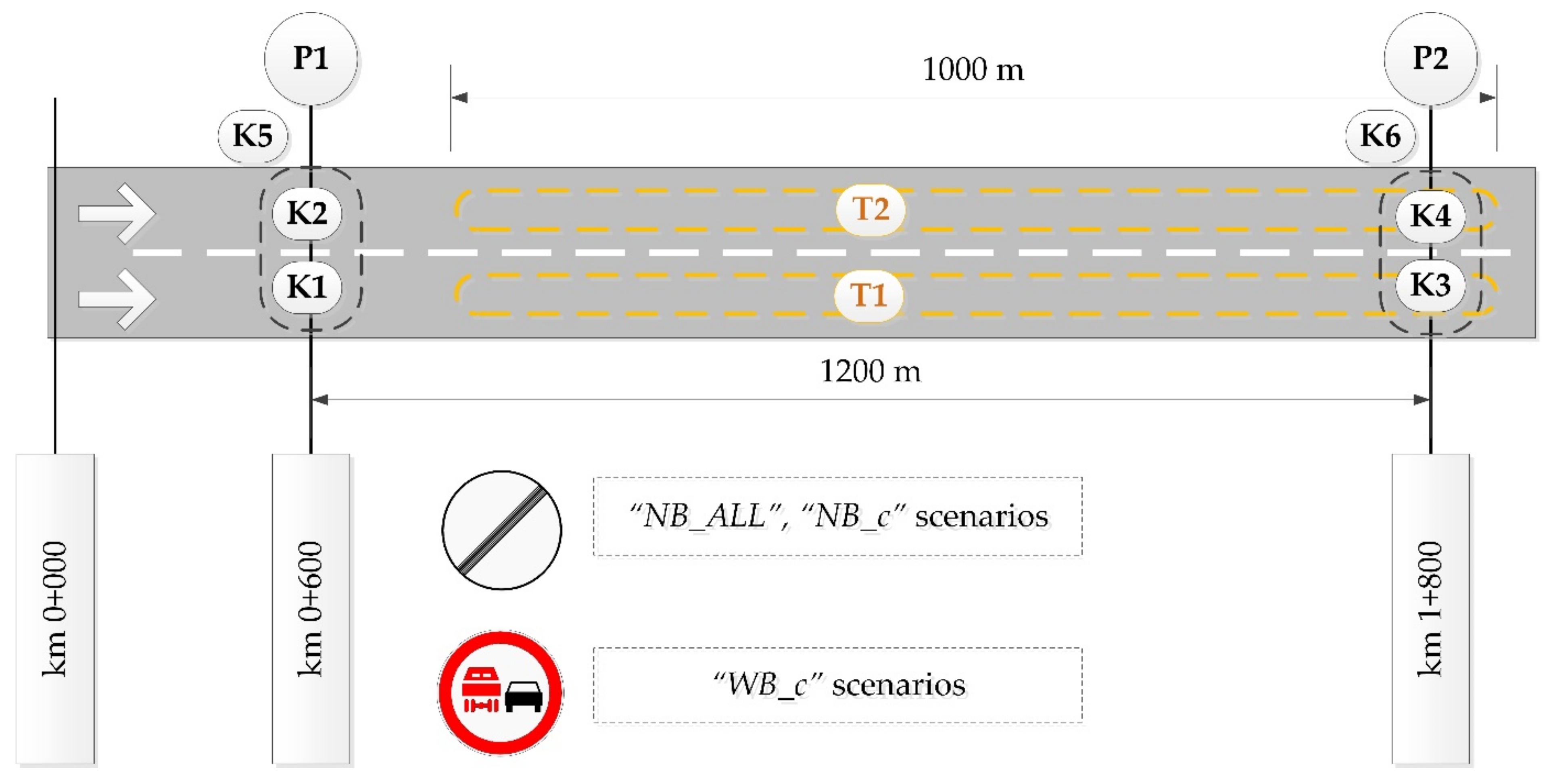

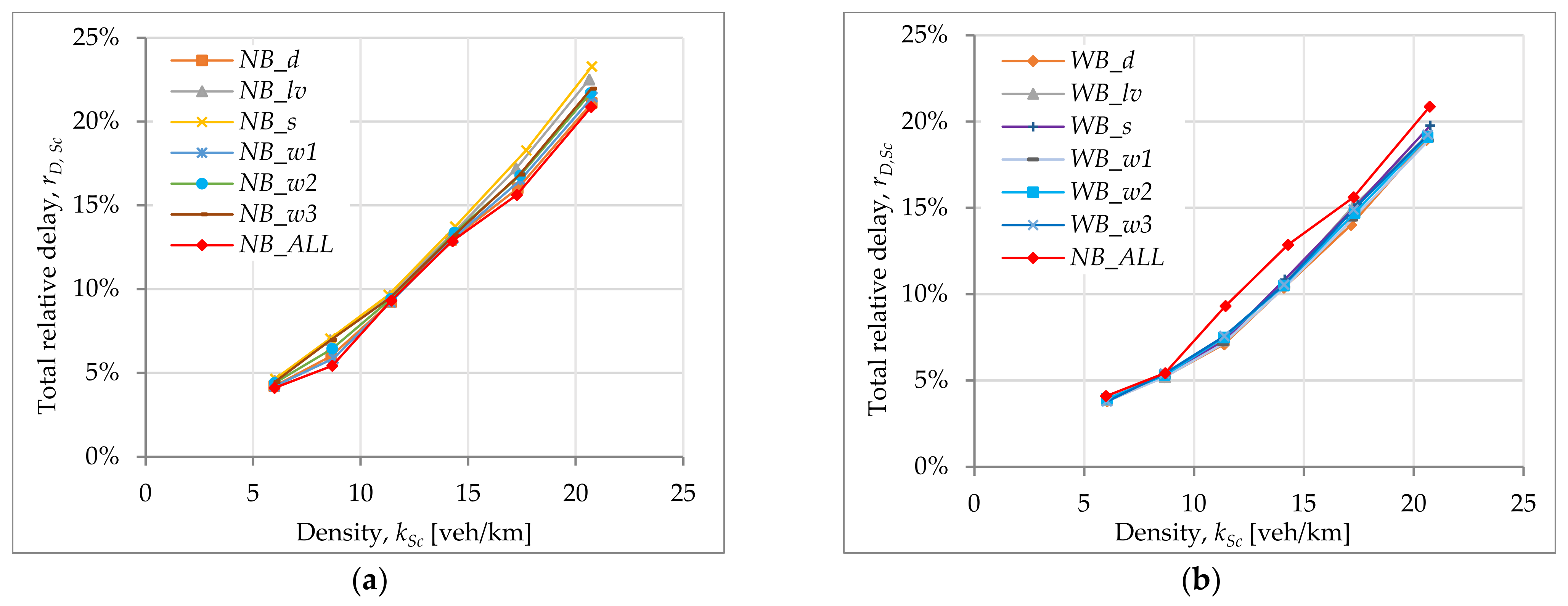
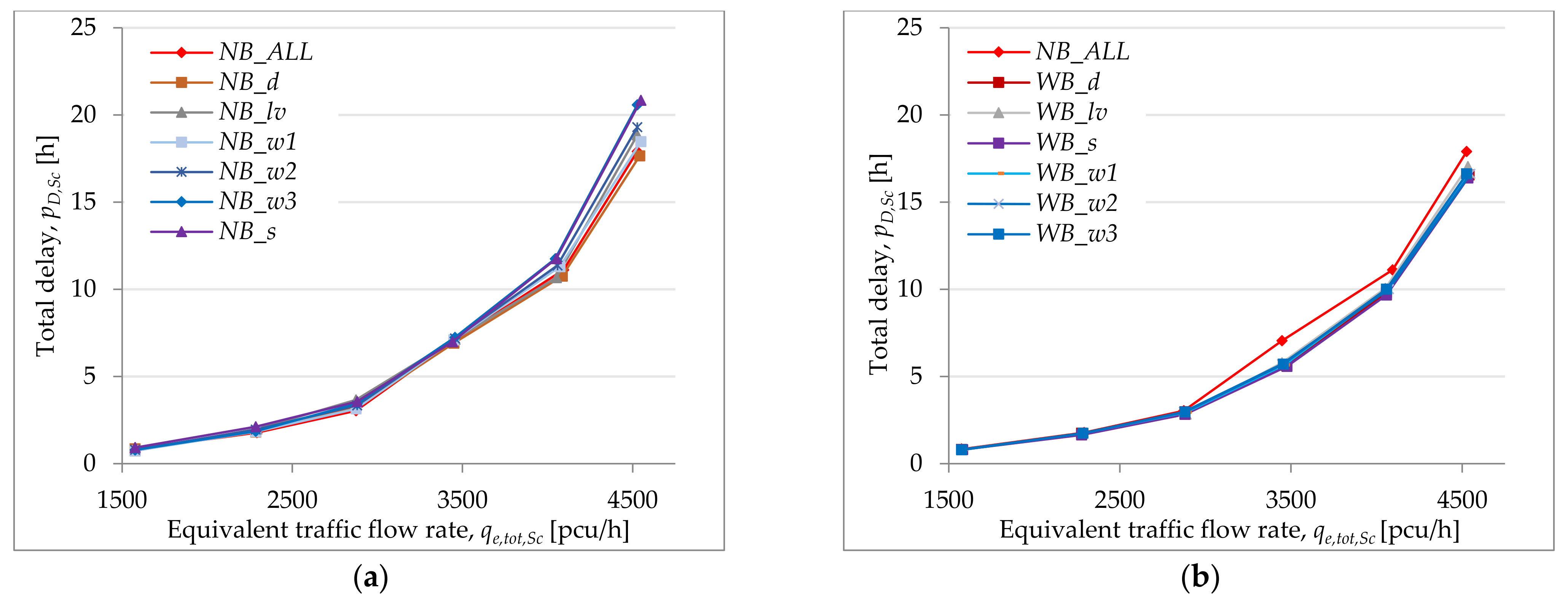
| kSc | rD,NB_ALL | kSc | rD,NB_d | kSc | rD,NB_lv | kSc | rD,NB_s | kSc | rD,NB_w1 | kSc | rD,NB_w2 | kSc | rD,NB_w3 |
|---|---|---|---|---|---|---|---|---|---|---|---|---|---|
| (veh/km) | (veh/km) | (veh/km) | (veh/km) | (veh/km) | (veh/km) | (veh/km) | |||||||
| 6.0 | 4.1% | 6.0 | 4.2% | 6.0 | 4.5% | 6.0 | 4.6% | 6.0 | 4.2% | 6.0 | 4.4% | 6.0 | 4.5% |
| 8.7 | 5.4% | 8.6 | 6.0% | 8.6 | 7.0% | 8.6 | 7.1% | 8.7 | 5.9% | 8.7 | 6.4% | 8.6 | 7.0% |
| 11.4 | 9.3% | 11.4 | 9.2% | 11.4 | 9.6% | 11.3 | 9.7% | 11.4 | 9.2% | 11.4 | 9.4% | 11.3 | 9.5% |
| 14.3 | 12.9% | 14.2 | 12.9% | 14.4 | 13.5% | 14.4 | 13.7% | 14.3 | 13.0% | 14.4 | 13.4% | 14.3 | 13.2% |
| 17.3 | 15.6% | 17.3 | 16.0% | 17.2 | 17.2% | 17.7 | 18.3% | 17.4 | 16.5% | 17.4 | 16.8% | 17.4 | 16.8% |
| 20.7 | 20.9% | 20.8 | 21.1% | 20.6 | 22.5% | 20.8 | 23.3% | 20.8 | 21.5% | 20.7 | 21.7% | 20.7 | 22.0% |
| 13.1 | 11.4% | 13.1 | 11.6% | 13.0 | 12.4% | 13.1 | 12.7% | 13.1 | 11.7% | 13.1 | 12.0% | 13.1 | 12.1% |
| kSc | rD,NB_ALL − rD,NB_d | rD,NB_ALL − rD,NB_lv | rD,NB_ALL − rD,NB_s | rD,NB_ALL − rD,NB_w1 | rD,NB_ALL − rD,NB_w2 | rD,NB_ALL − rD,NB_w3 | |||||||
| (veh/km) | |||||||||||||
| 6.0 | 2% | 10% | 13% | 2% | 7% | 9% | |||||||
| 8.7 | 11% | 28% | 30% | 8% | 19% | 28% | |||||||
| 11.4 | −1% | 3% | 4% | −1% | 1% | 1% | |||||||
| 14.3 | 0% | 5% | 7% | 1% | 4% | 3% | |||||||
| 17.3 | 3% | 10% | 17% | 6% | 7% | 8% | |||||||
| 20.7 | 1% | 8% | 12% | 3% | 4% | 5% | |||||||
| 13.1 | 2% | 9% | 12% | 3% | 6% | 7% | |||||||
| kSc | rD,NB_d − rD,NB_lv | rD,NB_d − rD,NB_s | rD,NB_d − rD,NB_w1 | rD,NB_d − rD,NB_w2 | rD,NB_d − rD,NB_w3 | ||||||||
| (veh/km) | |||||||||||||
| 6.0 | 7% | 10% | 0% | 5% | 6% | ||||||||
| 8.6 | 16% | 18% | −3% | 7% | 16% | ||||||||
| 11.4 | 4% | 5% | 0% | 2% | 2% | ||||||||
| 14.2 | 4% | 6% | 1% | 3% | 2% | ||||||||
| 17.3 | 7% | 14% | 3% | 5% | 5% | ||||||||
| 20.8 | 7% | 10% | 2% | 3% | 4% | ||||||||
| 13.1 | 7% | 10% | 1% | 4% | 5% | ||||||||
| kSc | rD,NB_ALL | kSc | rD,WB_d | kSc | rD,WB_lv | kSc | rD,WB_s | kSc | rD,WB_w1 | kSc | rD,WB_w2 | kSc | rD,WB_w3 |
|---|---|---|---|---|---|---|---|---|---|---|---|---|---|
| (veh/km) | (veh/km) | (veh/km) | (veh/km) | (veh/km) | (veh/km) | (veh/km) | |||||||
| 6.0 | 4.1% | 6.0 | 3.8% | 6.0 | 3.9% | 6.0 | 3.9% | 6.0 | 3.8% | 6.0 | 3.9% | 6.0 | 3.8% |
| 8.7 | 5.4% | 8.6 | 5.2% | 8.7 | 5.2% | 8.7 | 5.3% | 8.7 | 5.2% | 8.7 | 5.3% | 8.7 | 5.4% |
| 11.4 | 9.3% | 11.4 | 7.1% | 11.3 | 7.3% | 11.3 | 7.3% | 11.3 | 7.1% | 11.4 | 7.5% | 11.4 | 7.6% |
| 14.3 | 12.9% | 14.1 | 10.4% | 14.1 | 10.6% | 14.1 | 10.9% | 14.1 | 10.4% | 14.1 | 10.5% | 14.1 | 10.6% |
| 17.3 | 15.6% | 17.1 | 14.0% | 17.2 | 15.1% | 17.4 | 15.2% | 17.2 | 14.3% | 17.3 | 14.7% | 17.3 | 14.9% |
| 20.7 | 20.9% | 20.6 | 18.9% | 20.6 | 19.2% | 20.8 | 19.8% | 20.7 | 18.9% | 20.6 | 19.1% | 20.6 | 19.2% |
| 13.1 | 11.4% | 13.0 | 9.9% | 13.0 | 10.2% | 13.1 | 10.4% | 13.0 | 10.0% | 13.0 | 10.2% | 13.0 | 10.2% |
| kSc | rD,NB_ALL − rD,WB_d | rD,NB_ALL − rD,WB_lv | rD,NB_ALL − rD,WB_s | rD,NB_ALL − rD,WB_w1 | rD,NB_ALL − rD,WB_w2 | rD,NB_ALL − rD,WB_w3 | |||||||
| (veh/km) | |||||||||||||
| 6.0 | −7% | −5% | −4% | −7% | −4% | −8% | |||||||
| 8.7 | −4% | −4% | −2% | −4% | −2% | −1% | |||||||
| 11.4 | −24% | −21% | −22% | −24% | −20% | −19% | |||||||
| 14.3 | −19% | −18% | −16% | −19% | −18% | −18% | |||||||
| 17.3 | −10% | −3% | −3% | −8% | −6% | −5% | |||||||
| 20.7 | −9% | −8% | −5% | −9% | −8% | −8% | |||||||
| 13.1 | −13% | −10% | −9% | −12% | −10% | −10% | |||||||
| kSc | rD,NB_d − rD,WB_d | rD,NB_lv − rD,WB_lv | rD,NB_s − rD,WB_s | rD,NB_w1 − rD,WB_w1 | rD,NB_w2 − rD,WB_w2 | rD,NB_w3 − rD,WB_w3 | |||||||
| (veh/km) | |||||||||||||
| 6.0 | −10% | −14% | −15% | −9% | −10% | −15% | |||||||
| 8.6 | −13% | −25% | −25% | −11% | −18% | −22% | |||||||
| 11.4 | −23% | −24% | −25% | −23% | −20% | −20% | |||||||
| 14.2 | −20% | −21% | −21% | −20% | −21% | −20% | |||||||
| 17.3 | −12% | −12% | −17% | −13% | −12% | −11% | |||||||
| 20.8 | −10% | −15% | −15% | −12% | −12% | −12% | |||||||
| 13.1 | −15% | −17% | −18% | −15% | −15% | −16% | |||||||
| kSc | rD,WB_d − rD,WB_lv | rD,WB_d − rD,WB_s | rD,WB_d − rD,WB_w1 | rD,NB_d − rD,WB_w2 | rD,NB_d − rD,WB_w3 | ||||||||
| (veh/km) | |||||||||||||
| 6.0 | 2% | 4% | 0% | 4% | 0% | ||||||||
| 8.6 | 0% | 2% | 0% | 2% | 4% | ||||||||
| 11.4 | 3% | 2% | 0% | 6% | 7% | ||||||||
| 14.2 | 2% | 5% | 0% | 1% | 2% | ||||||||
| 17.3 | 8% | 8% | 2% | 5% | 6% | ||||||||
| 20.8 | 1% | 4% | 0% | 1% | 2% | ||||||||
| 13.1 | 3% | 5% | 1% | 3% | 3% | ||||||||
| qe,tot,Sc | pD,NB_ALL | qe,tot,Sc | pD,NB_d | qe,tot,Sc | pD,NB_lv | qe,tot,Sc | pD,NB_s | qe,tot,Sc | pD,NB_w1 | qe,tot,Sc | pD,NB_w2 | qe,tot,Sc | pD,NB_w3 |
|---|---|---|---|---|---|---|---|---|---|---|---|---|---|
| (pcu/h) | (h) | (pcu/h) | (h) | (pcu/h) | (h) | (pcu/h) | (h) | (pcu/h) | (h) | (pcu/h) | (h) | (pcu/h) | (h) |
| 1575 | 0.84 | 1575 | 0.85 | 1575 | 0.73 | 1575 | 0.92 | 1575 | 0.74 | 1575 | 0.79 | 1575 | 0.78 |
| 2291 | 1.78 | 2284 | 1.81 | 2291 | 1.98 | 2284 | 2.11 | 2284 | 1.83 | 2284 | 1.95 | 2284 | 1.85 |
| 2873 | 3.03 | 2873 | 3.21 | 2873 | 3.66 | 2880 | 3.56 | 2873 | 3.14 | 2880 | 3.34 | 2880 | 3.45 |
| 3448 | 7.05 | 3448 | 6.90 | 3455 | 7.13 | 3441 | 6.98 | 3448 | 7.09 | 3455 | 7.18 | 3455 | 7.24 |
| 4093 | 11.11 | 4086 | 10.75 | 4051 | 10.67 | 4051 | 11.75 | 4072 | 11.30 | 4058 | 11.36 | 4044 | 11.75 |
| 4526 | 17.91 | 4540 | 17.65 | 4526 | 18.85 | 4547 | 20.84 | 4547 | 18.47 | 4526 | 19.30 | 4526 | 20.58 |
| qe,tot,Sc | pD,NB_d/pD,NB_ALL | pD,NB_lv/pD,NB_ALL | pD,NB_s/pD,NB_ALL | pD,NB_w1/pD,NB_ALL | pD,NB_w2/pD,NB_ALL | pD,NB_w3/pD,NB_ALL | |||||||
| (pcu/h) | |||||||||||||
| 1575 | 1.02 | 0.87 | 1.10 | 0.89 | 0.95 | 0.94 | |||||||
| 2291 | 1.02 | 1.12 | 1.19 | 1.03 | 1.10 | 1.04 | |||||||
| 2873 | 1.06 | 1.21 | 1.17 | 1.04 | 1.10 | 1.14 | |||||||
| 3448 | 0.98 | 1.01 | 0.99 | 1.01 | 1.02 | 1.03 | |||||||
| 4093 | 0.97 | 0.96 | 1.06 | 1.02 | 1.02 | 1.06 | |||||||
| 4526 | 0.99 | 1.05 | 1.16 | 1.03 | 1.08 | 1.15 | |||||||
| qe,tot,Sc | pD,NB_ALL | qe,tot,Sc | pD,WB_d | qe,tot,Sc | pD,WB_lv | qe,tot,Sc | pD,WB_s | qe,tot,Sc | pD,WB_w1 | qe,tot,Sc | pD,WB_w2 | qe,tot,Sc | pD,WB_w3 |
|---|---|---|---|---|---|---|---|---|---|---|---|---|---|
| (pcu/h) | (h) | (pcu/h) | (h) | (pcu/h) | (h) | (pcu/h) | (h) | (pcu/h) | (h) | (pcu/h) | (h) | (pcu/h) | (h) |
| 1575 | 0.84 | 1575 | 0.85 | 1575 | 0.73 | 1575 | 0.92 | 1575 | 0.74 | 1575 | 0.79 | 1575 | 0.78 |
| 2291 | 1.78 | 2284 | 1.81 | 2291 | 1.98 | 2284 | 2.11 | 2284 | 1.83 | 2284 | 1.95 | 2284 | 1.85 |
| 2873 | 3.03 | 2873 | 3.21 | 2873 | 3.66 | 2880 | 3.56 | 2873 | 3.14 | 2880 | 3.34 | 2880 | 3.45 |
| 3448 | 7.05 | 3448 | 6.90 | 3455 | 7.13 | 3441 | 6.98 | 3448 | 7.09 | 3455 | 7.18 | 3455 | 7.24 |
| 4093 | 11.11 | 4086 | 10.75 | 4051 | 10.67 | 4051 | 11.75 | 4072 | 11.30 | 4058 | 11.36 | 4044 | 11.75 |
| 4526 | 17.91 | 4540 | 17.65 | 4526 | 18.85 | 4547 | 20.84 | 4547 | 18.47 | 4526 | 19.30 | 4526 | 20.58 |
| qe,tot,Sc | pD,WB_d/pD,NB_ALL | pD,WB_lv/pD,NB_ ALL | pD,WB_s/pD,NB_ALL | pD,WB_w1/pD,NB_ALL | pD,WB_w2/pD,NB_ALL | pD,WB_w3/pD,NB_ALL | |||||||
| (pcu/h) | |||||||||||||
| 1575 | 1.02 | 0.87 | 1.10 | 0.89 | 0.95 | 0.94 | |||||||
| 2291 | 1.02 | 1.12 | 1.19 | 1.03 | 1.10 | 1.04 | |||||||
| 2873 | 1.06 | 1.21 | 1.17 | 1.04 | 1.10 | 1.14 | |||||||
| 3448 | 0.98 | 1.01 | 0.99 | 1.01 | 1.02 | 1.03 | |||||||
| 4093 | 0.97 | 0.96 | 1.06 | 1.02 | 1.02 | 1.06 | |||||||
| 4526 | 0.99 | 1.05 | 1.16 | 1.03 | 1.08 | 1.15 | |||||||
| qe,tot,Sc | pD,WB_d/pD,NB_d | pD,WB_lv/pD,NB_ lv | pD,WB_s/pD,NB_s | pD,WB_w1/pD,NB_w1 | pD,WB_w2/pD,NB_w2 | pD,WB_w3/pD,NB_w3 | |||||||
| (pcu/h) | |||||||||||||
| 1575 | 0.96 | 0.94 | 0.88 | 1.06 | 1.01 | 1.01 | |||||||
| 2291 | 0.96 | 0.84 | 0.78 | 0.94 | 0.89 | 0.94 | |||||||
| 2873 | 0.93 | 0.78 | 0.79 | 0.94 | 0.89 | 0.86 | |||||||
| 3448 | 0.82 | 0.81 | 0.80 | 0.80 | 0.80 | 0.79 | |||||||
| 4093 | 0.91 | 0.94 | 0.82 | 0.88 | 0.88 | 0.85 | |||||||
| 4526 | 0.94 | 0.90 | 0.79 | 0.89 | 0.86 | 0.81 | |||||||
Publisher’s Note: MDPI stays neutral with regard to jurisdictional claims in published maps and institutional affiliations. |
© 2022 by the authors. Licensee MDPI, Basel, Switzerland. This article is an open access article distributed under the terms and conditions of the Creative Commons Attribution (CC BY) license (https://creativecommons.org/licenses/by/4.0/).
Share and Cite
Rijavec, R.; Marsetič, R.; Strnad, I. Effectiveness of the Overtaking Ban for Heavy Vehicles on the Four-Lane Divided Highway in Different Weather Conditions. Appl. Sci. 2022, 12, 10169. https://doi.org/10.3390/app121910169
Rijavec R, Marsetič R, Strnad I. Effectiveness of the Overtaking Ban for Heavy Vehicles on the Four-Lane Divided Highway in Different Weather Conditions. Applied Sciences. 2022; 12(19):10169. https://doi.org/10.3390/app121910169
Chicago/Turabian StyleRijavec, Robert, Rok Marsetič, and Irena Strnad. 2022. "Effectiveness of the Overtaking Ban for Heavy Vehicles on the Four-Lane Divided Highway in Different Weather Conditions" Applied Sciences 12, no. 19: 10169. https://doi.org/10.3390/app121910169
APA StyleRijavec, R., Marsetič, R., & Strnad, I. (2022). Effectiveness of the Overtaking Ban for Heavy Vehicles on the Four-Lane Divided Highway in Different Weather Conditions. Applied Sciences, 12(19), 10169. https://doi.org/10.3390/app121910169







